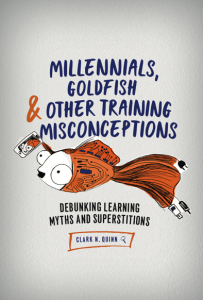This past week, I spent two days at ATD’s Techknowledge conference. I gave a talk on ‘transforming learning’, and another (largely) on myths. And I participated in a couple other things, including helping out a colleague for her session. But I want to reflect on the rest of the event. So here’s an ATD TK2020 retrospective.
First, I should note, I did not mindmap the keynotes (in case you missed them). I used to do it all the time. However, the app that I used to do it has a new edition out, and it’s pricey. And, I don’t have enough other use for it. I can sketch out ideas in my note-taking app. So…guess that’s gone by the wayside. We’ll see if I find out an alternative.
I did try to take notes. And, because I’d read recently that drawing was a better note-taking technique (don’t recall the exact link, but this suggests the benefit), I tried to draw. Old habits…I mostly wrote. And they weren’t worth publishing.
The conference itself was interesting because they were experimenting. For instance, there was no expo. Vendors had suites, and several tried to get me to meet with them. But didn’t have a viable business case for me to care (I’m not a candidate for your LMS, for instance ;). And they were set up to have several simultaneous speakers at the same time. Even on the same stage!
What I’m talking about here is that there was this little audio device you hung around your neck. It had 6 channels, and a plug for earphones (also provided). So, right after the opening keynote, there was the first of what they called ‘supersessions’. Here, three people were up on different parts of the same stage, and gave three different talks. You set the channel to the one you wanted to hear (or the two you wanted to switch between ;). And, it worked. Largely. One of the presenters for one of the sessions kept running around and interacting (interrupting) the others.
And there were six stages in one room, and you could jump between them, or sit and listen to one. Without, note, being distracted by the others. On the other hand, it was hard to have audience interaction. They couldn’t hear one another, and for instance the one I did I really could’ve benefited from a flip chart (which I asked for but didn’t get). Still, it largely worked.
There were some more traditional talks in another room (I did one of those, too). And they were, well, familiar. Not that that’s a bad thing.
One other thing that was interesting was a ‘hackathon’. Here, a worthwhile not-for-profit posed a challenge and volunteers were divided up into teams to address it. Unfortunately, it seemed to be more focused on visual design. I tend to think that infusing learning science is more likely to be a problem in their elearning. (So, of course, I made that my own challenge.) Still, it helped the org, and provided an opportunity to interact.
I ran into my friends and colleagues more, and the discussions were perhaps a little easier to engage in. I liked the more intimate feel. Though I confess to having missed the expo (perhaps because I couldn’t find as much to criticize!). And the food was quite good (the Wed lunch in particular).
I did note that there were still some zombies running around. There was a dialog between two folks who were supposedly talking about the future of work, but played a lot of the ‘millennial’ card. Bad speaker, no Twinkie!
Overall, I laud their willingness to experiment. I know the Guild does a fair bit of it as well, but this was more unusual from a large (and often inflexible) organization. As a fan of ‘learning out loud’, I hope it’s useful to provide an ATD TK2020 retrospective, and if you were there, I welcome your thoughts!

